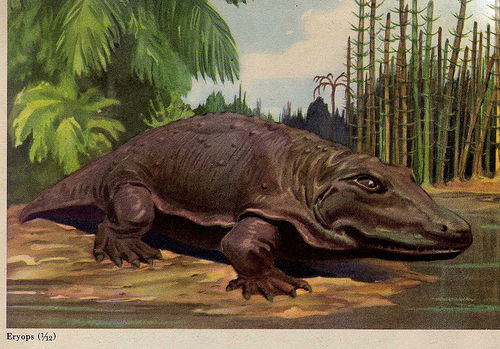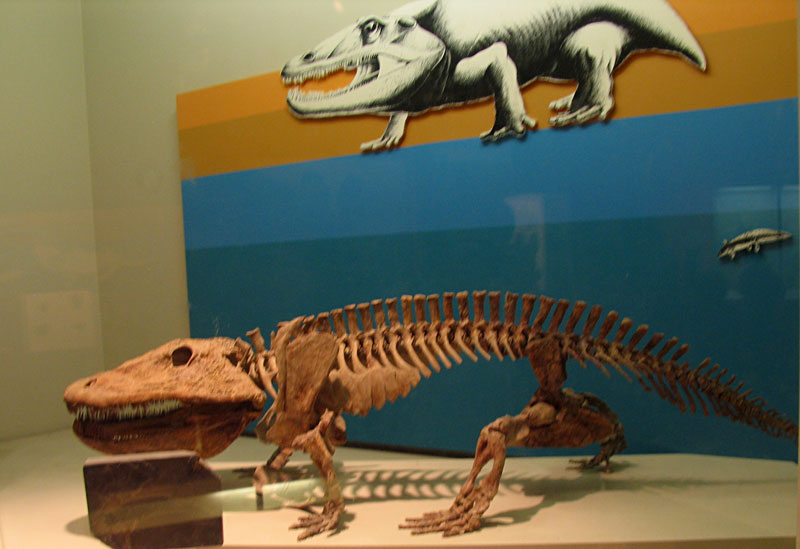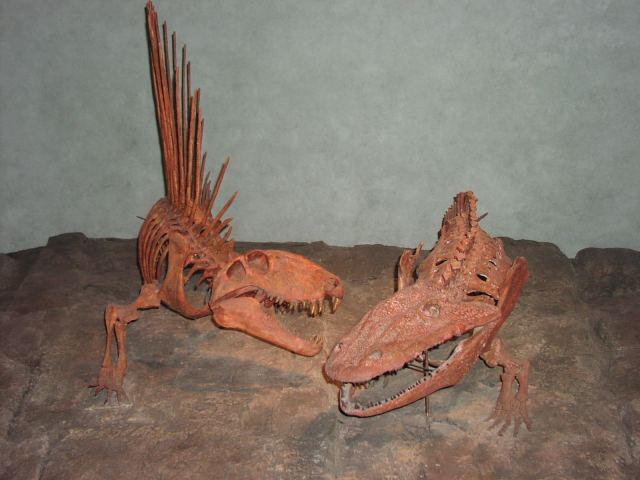[Recent Entries][Archive][Friends][User Info]
| October 4th, 2011 | |
|---|---|
| 07:50 pm [industrialterro] [Link] |
Eryops Эриопс (Eryops megacephalus) – представитель темноспондилов позднекаменноугольной - раннепермской эпохи. Типовой род семейства Eryopidae, один из самых известных темноспондилов. Крупное животное, с длиной черепа до 50 см, общая длина до 2 метров. Череп массивный, по очертаниям напоминает череп аллигатора, сильно скульптирован. Верхняя поверхность черепа несет продольные гребни позади глаз и ноздрей. Зубы крупные, развиты небные «клыки». Скелет массивный, конечности короткие, но мощные. Ребра расширены для укрепления грудной клетки. Тело боченковидное, остистые отростки спинных позвонков довольно высокие, лопатка мощная. На спине присутствуют единичные кожные чешуи. Таз массивный. Хвост средней длины. Вероятно, полуводный хищник. Род описан Э.Д. Коупом из ранней перми (вольфкамп) Техаса в 1877 году. Типовой вид - E. megacephalus. Примерно 5 – 6 видов из позднего карбона – ранней перми Северной Америки. К семейству Eryopidae относятся также:
Род Sclerocephalus может также относиться к эриопидам, хотя иногда его выделяют в особое семейство и сближают с архегозаврами. The skull of Eryops is proportionately large, being broad and flat and reaching lengths of 60 centimeters (2 ft). The skull resembled that of a salamander. It had an enormous mouth with many sharp teeth in strong jaws. Its teeth had enamel with a folded pattern, hence its classification with the labyrinthodonts ("maze toothed"). Within the wide, gaping jaw, the fang-like palatal teeth, when coupled with the gape, suggest an inertial feeding habit. This is when the amphibian would grasp its prey and, lacking any chewing mechanism, toss its head up and backwards, throwing the prey farther back into its mouth. Such feeding is seen today in the crocodile and alligator. It is taken that Eryops was not very active, thus a predatory lifestyle, while possible, was probably not the norm. It is more likely that it fed on fish either in the water or on those that became stranded at the margins of lakes and swamps. A large supply of terrestrial invertebrates were also abundant at the time, and this may have provided a fairly adequate food supply in itself. Eryops’ eye sockets were large and directed upward. The body was low to the ground and supported by short, massive limbs. The tail was short, suggesting the animal was not a fast or powerful swimmer. The flat skull with the large eyes and nostrils placed on the top of the head are suggestive that Eryops used stealth for hunting, much like a modern crocodile, and sat quietly in the water waiting for prey with only its eyes and nostrils visible above the water. The pectoral girdle of Eryops was highly developed, with a larger size for both increased muscle attachment to both it and the limbs. Most notably, the shoulder girdle was disconnected from the skull, resulting in improved terrestrial locomotion. The crossopterygian cleithrum was retained as the clavicle, and the interclavicle was well-developed, lying on the underside of the chest. In primitive forms, the two clavicles and the interclavicle could have grown ventrally in such a way as to form a broad chest plate, although such was not the case in Eryops. The upper portion of the girdle had a flat scapular blade, with the glenoid cavity situated below performing as the articulation surface for the humerus, while ventrally there was a large flat coracoid plate turning in toward the midline. The pelvic girdle also was much larger than the simple plate found in fishes, accommodating more muscles. It extended far dorsally and was joined to the backbone by one or more specialized sacral ribs. The hind legs were somewhat specialized in that they not only supported weight, but also provided propulsion. The dorsal extension of the pelvis was the ilium, while the broad ventral plate was composed of the pubis in front and the ischium behind. The three bones met at a single point in the center of the pelvic triangle, called the acetabulum, providing a surface of articulation for the femur. The main strength of the ilio-sacral attachment of Eryops was by ligaments, a condition structurally, but not phylogenetically, intermediate between that of the most primitive embolomerous amphibians and early reptiles. The condition that is more usually found in later vertebrates is that cartilage and fusion of the sacral ribs to the blade of the ilium are utilized in addition to ligamentous attachments. Like most modern amphibians, Eryops breathed by inhaling air into lungs, where oxygen was absorbed and CO2 released. However, unlike modern amphibians, Eryops probably could not respire effectively through its skin, as its large size would have resulted in a low surface area to volume ratio. Unlike modern amphibians, its ribs were well-developed, but were immobile, preventing ventilation by expanding the body cavity. Thus, Eryops probably breathed via buccal pumping, in which the hyoid apparatus raises and lowers the floor of the mouth in order to pump air into the lungs. Eryops had typical amphibian posture exhibited by the upper arm and upper leg extending nearly straight out from its body, while the forearm and the lower leg extended downward from the upper segment at a near right angle. The body weight was not centered over the limbs, but was rather transferred 90 degrees outward and down through the lower limbs, which contacted the ground. Most of the animal's strength was used to just elevate its body off the ground for walking, which was probably slow and difficult. With this sort of posture, only short, broad strides could be achieved. This has been confirmed by fossilized footprints found in Carboniferous rocks. Ligamentous attachments within the limbs were present in Eryops, being important because they were the precursor to bony and cartilagenous variations seen in modern terrestrial animals that use their limbs for locomotion. The primary species of Eryops has been named Eryops megacephalus (“big head”).
В "уютной" компании диметродона.
Ископаемые останки (1, 2, 3, 4, 5, 6):
А это его предполагаемый головастик:
Tags: Вымершие амфибии, Карбон, Лабиринтодонты, Темноспондилы |












